1. Technical background
In recent years with the construction and development of high-speed railway in China great achievements have been made in the development of railway industry. However with the large-scale operation of high-speed railway and the increase of passenger and freight traffic higher requirements are put forward for the safe operation of railway. As an important part of railway facilities rails may produce various defects at any time during the wheel-rail contact process so the inspection of rail defects is particularly important. Rail surface crack is one of the defects. With the continuous impact of the train running at any time the small crack on the rail surface may continue to grow inside and eventually form a large crack which may even lead to rail breaking accidents and there are serious security risks. The use of advanced technical methods to efficiently and reliably detect rail fatigue crack defects and achieve early prediction of potential accidents are very important for the safety of railway transportation and even the development of the national economy. At present ultrasonic testing is mainly used to detect the rails which solves the inspection of most defects of the rail and plays a great role in rail maintenance. However due to the insensitivity of ultrasonic testing to surface defects and the complexity of on-site working conditions it is difficult to judge or even detect the surface crack defects of some special parts of the rail which makes the rail detection have a certain blind area. Eddy current testing is a kind of nondestructive testing technology which is good at surface defect detection and has high sensitivity to surface defects. It does not need coupling agent and contact and can reliably detect the crack position and direction and measure the crack depth [1]. Eddy current testing can make up for the deficiency of ultrasonic testing on the rail surface and form a certain complementary advantage with ultrasonic testing.
2. Principle of eddy current detection
Eddy current testing is a conventional nondestructive detection technology based on the principle of electromagnetic induction [2]. The principle is shown in Figure 1. Drive the probe coil with AC voltage to generate an alternating magnetic field when the probe moves to the area to be detected of the conductive material the probe will generate eddy current in the conductor under test. When there is defect on the surface or near the surface of the conductor it will affect the strength and distribution of the eddy current. The change of eddy current will cause the change of the probe voltage and impedance. According to this change we can indirectly know whether there is any defect in the conductor [3] [4]. Figure 2 shows the effect of crack on eddy current on conductor surface.

Fig. 1
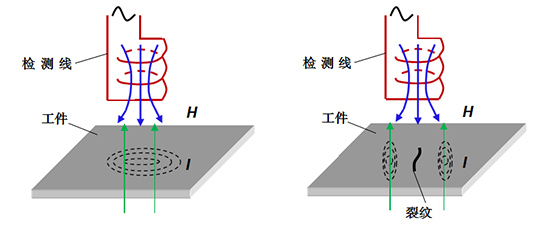
Fig. 2 Effect of crack on eddy current
3. Advantages of eddy current detection technology
a.Contact-free.
b.Couplant-free.
c.High sensitivity on surface and subsurface defects.
d.Fast detection speed and high efficiency.
e.Simple detection operation and low labor intensity.
f.No special training is required and the requirements for flaw detection personnel are low.
g.Can be detected under high temperature.
h.Do no require the removal of surface rust and coating.
i.The test results can be displayed in real time and stored for a long time through disk and can be played back and reproduced when necessary and analyzed.
4. Eddy current testing system and scheme
General eddy current detection system is mainly composed of eddy current detection instrument special eddy current probe for rail probe line tested workpiece etc. Combined with the eddy current principle and the characteristics of eddy current detection only one eddy current instrument is needed to use the special eddy current probe to carry out scanning on the inspected part of rail and you can immediately see whether there are cracks and the situation of the cracks on the rail surface can be obtained immediately as shown in Figure 3.
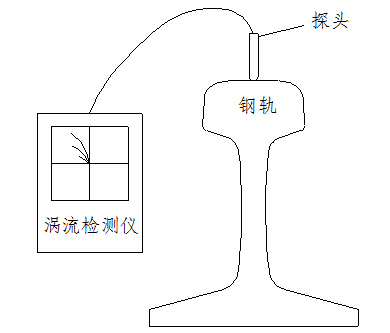
Fig. 3 Eddy current detection scheme of rail
This scheme uses the CTS-608 rail eddy current detector of Guangdong Goworld Co. Ltd. Ultrasonic Instrument Branch. As shown in FIG. 4 a) the instrument is portable and practical small in size light in weight simple in operation and low in power consumption and can work continuously for more than 6 hours under battery power supply. The instrument has a built-in special process for detecting cracks on the rail surface which can realize rapid detection of rail surface crack. Using the probe moving around the rail to be inspected the existence of cracks on the rail surface can be determined by the display of the impedance plane of the instrument. Moreover the algorithm of crack depth curve embedded in the instrument can calibrate the crack depth automatically calculate the actual crack depth and display it in real time which is very suitable for the rapid detection and evaluation of rail surface cracks. The detection process does not need coupling agent is contact-free convenient intuitive and fast.
According to the characteristics of rail eddy current detection and the location of rail crack our company has independently developed several special eddy current probes for rail such as the probe for rail bottom the probe for rail weld and the probe for switch rail. As the special design of the probe structure the lift off effect is less and the detection is more convenient which realizes the efficient fast and accurate detection of the surface cracks in different parts of the rail. As shown in Fig. 4b).
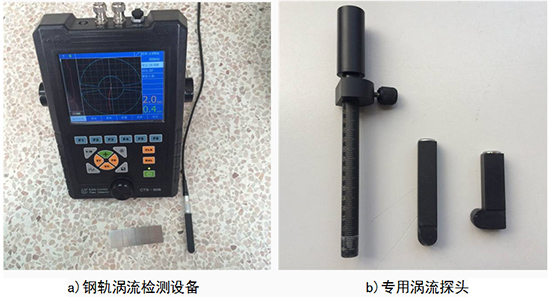
Fig. 4 Eddy current detection system
5. Detection applications
5.1 Surface crack detection of rail head
For rail surface crack detection we use eddy current probe for rail welding seam detection. Place the probe vertically on the inspection surface of rail head and move the probe for inspection. As shown in Fig. 5 a) is the rail tread crack b) is the effect of eddy current detection. This method is also suitable for the detection of other same surface conditions.
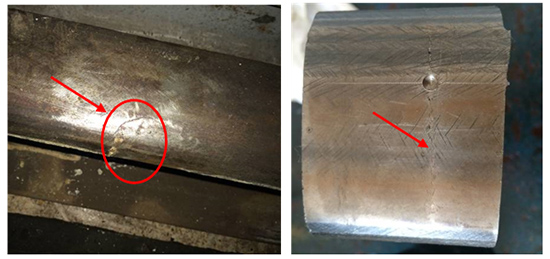
a) Tread crack
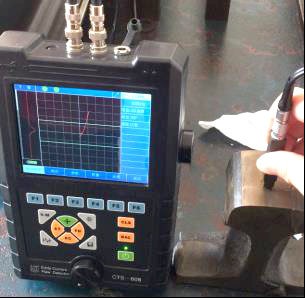
b) Inspection effect of Tread
Fig. 5 Detection of surface cracks on rail head
5.2 Surface crack detection of rail welding seam
With the gradual seamlessness of the rail lines more and more weld joints are welded and the increase of transportation capacity and volume also makes the weld damage gradually increase so the weld damage has become one of the main damages endangering the safety of the railway. Due to the high-speed running of the train surface cracks are easy to occur near the boundary of the rail welding seam which has a great potential safety hazard. Because of the special location it is difficult to find by other detection methods or the detection process is very complex. Using eddy current detection method a special probe is used to complete the inspection of the weld boundary along the weld boundary from the bottom slope of the weld rail through the rail waist to the lower jaw of the rail head the operation is simple the detection speed is fast and the efficiency is high. As shown in Fig. 6 is the effect diagram of the rail eddy current detection on the rail waist crack at the boundary.

Fig. 6 Detection effect of 6mm deep artificial crack on rail waist
5.3 Surface crack detection under the rail
At present cracks often appear on the rail bottom especially on the surface under the welded rail such as crescent injuries etc which also affect the safety of railway transportation. By using eddy current detection method and special probe to scan from left to right at the rail bottom the existence of cracks can be quickly obtained. As shown in Figure 7 you can see the detection effect of 4mm deep artificial crack on the rail bottom.
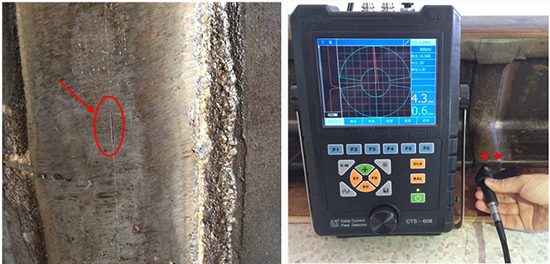
Fig. 7 Detection effect of 4mm deep artificial crack on rail bottom
5.4 Surface crack detection on switch rail
Switch rail is an important part of turnout. It can lead the train into the direction of main line or side line by pulling switch rail. The high-speed train has a great impact on the switch rail which is easy to wear and damage. The surface crack is one of them. Similarly the special probe or weld probe can be used to detect the surface crack of the switch rail and the depth of the crack can be known. As shown in Figure 8 is the eddy current detection effect of the crack on the switch rail.
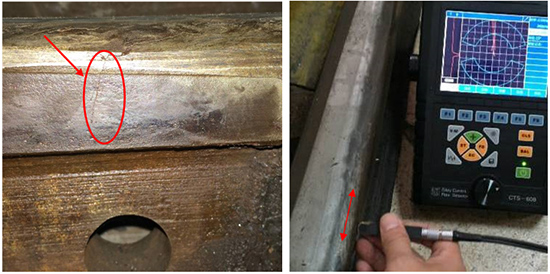
a) Transversal crack of switch rail

b) Longitudinal horizontal crack on the side of switch rail
Fig. 8 Eddy current detection effect of switch rail cracks
6. Conclusion
In the detection of rail surface cracks eddy current detection is a relatively fast and simple feasible method. Eddy current detection is sensitive to surface cracks which can be used to detect the surface cracks on special parts of rails and also can be used as a means of reviewing and confirming the surface defects of the rail. It has complementary advantages with ultrasonic testing so that the rail flaw detection can be more comprehensive. Eddy current testing does not need coupling agent is contact-free low requirements on rail surface fast detection speed high efficiency and can accurately identify whether there is crack and display the depth of crack. At the same time there are not too many requirements for flaw detection personnel no special training simple and easy to learn.





